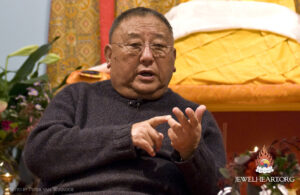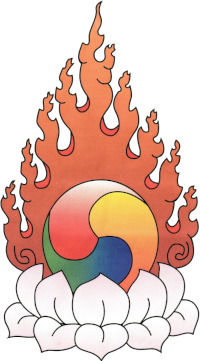The root text we are using is about taking the path leading to the ultimate fully enlightened stage. I will give a very brief and short explanation, so that you can really gain some kind of understanding of what it is. In the sutra path, there are three major principles that have a lot of minor points within them; that is why this text is named Three Principles of the Path. What are these three major principles?
1. Determination to be free, renunciation, seeking freedom or developing love for yourself. There are different translations for this. The word in Tibetan is, ‘ngen-jung.’ ‘Nge-par,’ means definite; ‘jung-wa,’ means definitely obtaining. So some call it, “determination to be free,” or “seeking freedom,” which seems to me a better translation than “renunciation,” which is how others translate it. So the first point is building up the resolution, “Definitely I would like to be free.” That is the first principle.
When you say, “Definitely I would like to be free,” everybody will agree right away. Nobody wants to be a slave; everybody wants to be free. But simply saying that will not help. You have to get into it deeply: free from what? For what?
First, you have to see: free from what? All the points dealing with the nature of life and so forth fall into the category of determination to be free. The purpose here is to build a desire and a proper intention to really determine to free oneself. For that, we need to have the proper motivation.
You can say, “I already have the proper motivation, I’d like to be free.” That is not right; proper motivation for a determination to be free requires really seeing the faults on the one side and the qualities on the other side, and balancing them within you. Then you judge, you make up your mind without anybody’s pressure and with- out depending on your intuition. Properly seeing the facts, you balance them and make your decision and go in the direction you choose. That is what it really is. To develop this needs time, labor, meditation, information, all of these. That is the first principle.
2. Altruism. The second principle is to realize that it is not enough that I should free myself alone. What about others, my nearest and dearest, the persons that I care about most, what about all of them? Do I walk away from them, saying that I found some way out for myself and I don’t care about them? Do I say, “Bye, bye!” and walk away? Or do I care about them and love them and do something? That is the second question. So love- compassion and the ultimate altruistic attitude, or bodhimind, is built up in the second principle.
3. Perfect view. The determination to be free alone is not enough. Love-compassion is not enough. We need the real antidote, the meditation on true understanding or wisdom, what we call perfect view: how to look into total reality without influence of the dualistic mind or delusion. Totally free from delusion, free from dualistic influence looking into the nature of reality as nakedly as possible; that is what we call perfect view. That is the third path.
Now the question rises of what to do with these three principles? You have to meditate on them and practice them. This will bring your spiritual level up; it takes you onto the path. And if your vehicle is good, you reach there very fast; if your vehicle is medium you go normally, and if you vehicle is bad you go so-so, but you go. That’s what it is.
~ Gelek Rimpoche, The Three Principles of the Path, 1994, p. 38


